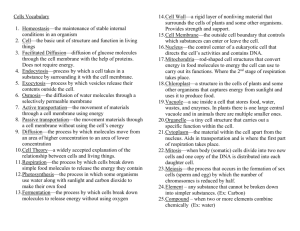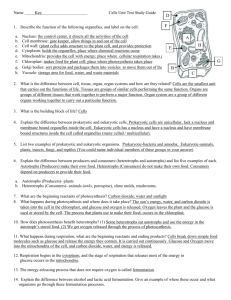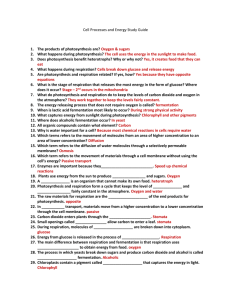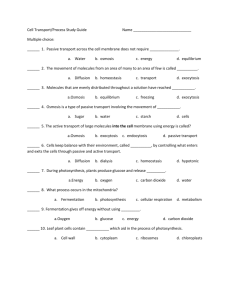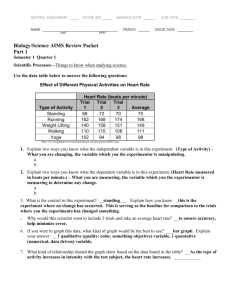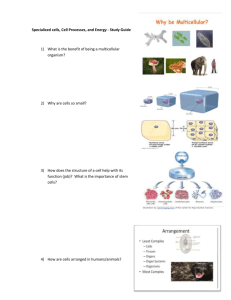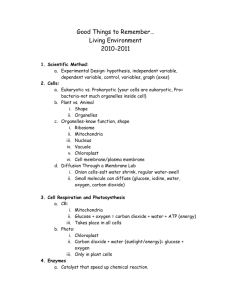Cells and Heredity
advertisement
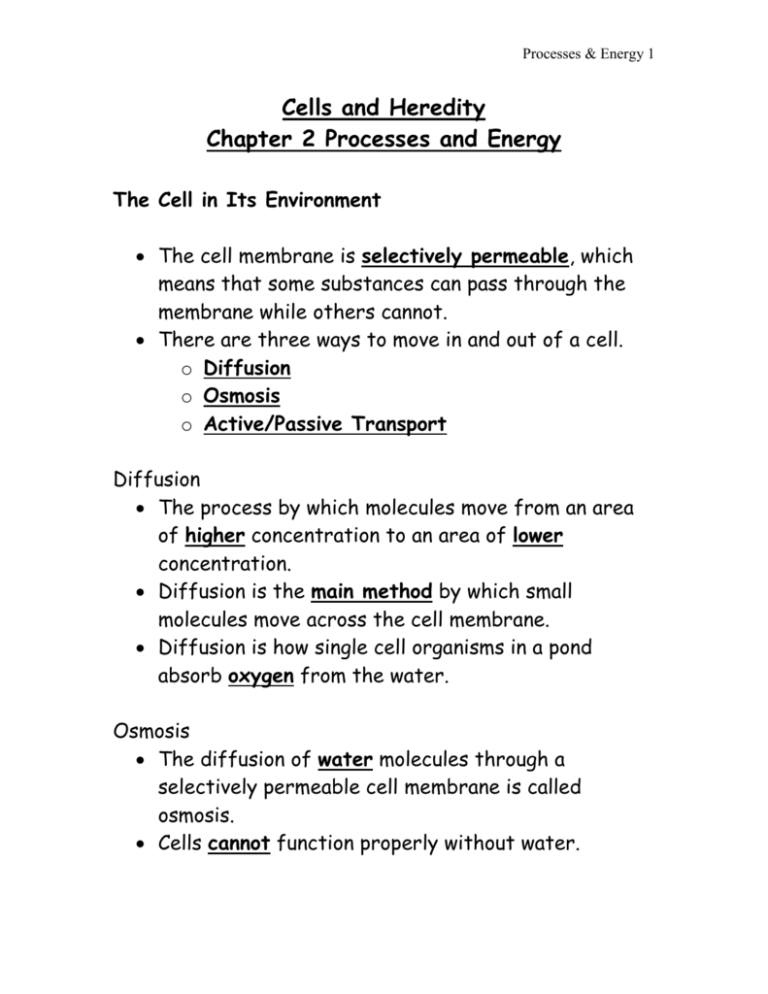
Processes & Energy 1 Cells and Heredity Chapter 2 Processes and Energy The Cell in Its Environment The cell membrane is selectively permeable, which means that some substances can pass through the membrane while others cannot. There are three ways to move in and out of a cell. o Diffusion o Osmosis o Active/Passive Transport Diffusion The process by which molecules move from an area of higher concentration to an area of lower concentration. Diffusion is the main method by which small molecules move across the cell membrane. Diffusion is how single cell organisms in a pond absorb oxygen from the water. Osmosis The diffusion of water molecules through a selectively permeable cell membrane is called osmosis. Cells cannot function properly without water. Processes & Energy 2 Transport Passive transport does not require the cells energy to transport dissolved materials through the cell membrane. Active transport requires the cell to use its own energy to move materials through the cell membrane. Transport proteins “pick up” molecules like calcium, potassium and sodium and transport them in or out of cells. When a cell absorbs materials by surrounding and encloses a vacuole it’s called engulfing. Photosynthesis The process by which a cell captures energy in sunlight and uses it to make food is called photosynthesis. Nearly all living things obtain energy either directly or indirectly from the energy of sunlight captured during photosynthesis. An autotroph is an organism that makes its own food. A heterotroph cannot make its own food. Processes & Energy 3 Two Stages of Photosynthesis In the first stage chloroplasts in plant cells capture energy from sunlight. The green color comes from colored chemical compounds called pigments. In the second stage, the captured light energy is used to produce sugars and oxygen from water and carbon dioxide. Carbon dioxide enters the leaf through openings called stomata. Water enters the plant through roots and moves upward to the leaf. Oxygen exits the plant through the stomata. The Photosynthesis Equation 6 CO2 + 6 H2O + light energy ---› C6H12O6 + 6 O2 Carbon Dioxide, Water & Sunlight yields Sugar and Oxygen Respiration Cellular Respiration is the process by which cells obtain energy from glucose. Respiration is also used to describe the exchange of air in and out of your lungs. (Breathing) Processes & Energy 4 What is Respiration? Cells break down simple food molecules such as sugar and release the energy they contain. Autotrophs capture energy in the form of sunlight and “store” it in the form of carbohydrates such as sugars and starches. Heterotrophs “withdraw” energy from the food they eat by breaking it down into carbohydrates. The Two Stages of Respiration In stage one the glucose is broken down into smaller molecules releasing small amounts of energy. In the second stage the mitochondria combine the smaller particles with oxygen to produce water, carbon dioxide and large amounts of energy. The Respiration Equation C6H12O6 + 6 O2 ---› 6 CO2 + 6 H2O + Energy Sugars and Oxygen yields Carbon Dioxide, Water and Energy Fermentation Fermentation is and energy –releasing process that does not require oxygen. Alcoholic fermentation occurs when yeast and some other single celled organisms break down sugars. Lactic acid fermentation occurs when your muscles use up oxygen faster then it can be replaced. Processes & Energy 5 Cell Division The regular sequence of growth and division that cells undergo is known as the cell cycle. The cell cycle is divided into three main stages: o Interphase o Mitosis o Cytokinesis Interphase During interphase the cell grows, makes a copy of its DNA and prepares to divide into two cells. New ribosomes and enzymes are produced. The mitochondria and chloroplasts are copied. An exact copy of the DNA is produced in a process called replication. Finally centrioles are produced. Mitosis During mitosis the cell’s nucleus divides into two new nuclei. The DNA forms into chromosomes and a copy is distributed into each of the two daughter cells. Mitosis is divided into four phases: o Prophase o Metaphase o Anaphase o Telophase Processes & Energy 6 Cytokinesis During cytokinesis the cytoplasm divides and the organelles are distributed into each of the two new cells. In animal cells the membrane pinches together forming two new cells. In plant cells, a cell plate forms in the center separating the cell into two new cells. Eventually the cell plate becomes a new cell wall. Structure and Replication of DNA DNA stands for DeoxyriboNucleic Acid. DNA contains the genetic information cells need to carry out their activities. There are four types of nitrogen bases, or molecules containing nitrogen and other elements that make up DNA. They are: o Adenine o Thymine o Guanine o Cytosine Processes & Energy 7 Cancer Cancer is a disease in which cells grow and divide uncontrollably. There are more than 100 types of cancer. Cancer can form in any part of the body. Damaged chromosomes cause a change in the DNA called a mutation. Cancer begins when mutations disrupt the normal cell cycle. Cancerous cells can take years to grow into a noticeable size or mass called a tumor. The cancer spreads when parts of the tumor break off and enter the bloodstream. Treating and Preventing Cancer There are three common ways to treat cancer: o Surgery o Radiation o Chemotherapy (drugs) Radiation affects the fast-growing cancer cells more than the normal cells. Chemotherapy is the use of drugs that destroy the cancer cells. People can reduce the risk of cancer by: o Avoid smoking. o Eat a healthy diet. o Protect your skin from UV rays. o Exercise regularly.

